Impact of Workplace Factors on Worker Productivity - Report
VerifiedAdded on 2020/03/02
|7
|2127
|121
Report
AI Summary
This report examines the impact of various workplace factors on worker productivity, drawing insights from research and case studies. It explores the evolution of office design, from open spaces to cubicles and coworking environments, and analyzes how these designs affect employee performance. The report highlights the importance of considering office spaces as strategic tools for growth, emphasizing the role of collaboration, digital communication, and data-driven insights in optimizing workspaces. It discusses the benefits of coworking, increased interactions, and innovative office designs in fostering creativity and engagement. The report also addresses the need for balancing interactions to prevent energy level drops, and the importance of investing in group productivity rather than solely focusing on individual performance. Ultimately, the report concludes that innovative office spaces and increased collaboration are key to boosting worker productivity, innovation, and overall company success.

Impact of Workplace Factors on worker Productivity
Week 2:Trends in Global Environment
Student Name: Student ID:
Subject Name: Subject ID:
Date Due: Professor Name:
1 | P a g e
Week 2:Trends in Global Environment
Student Name: Student ID:
Subject Name: Subject ID:
Date Due: Professor Name:
1 | P a g e
Paraphrase This Document
Need a fresh take? Get an instant paraphrase of this document with our AI Paraphraser
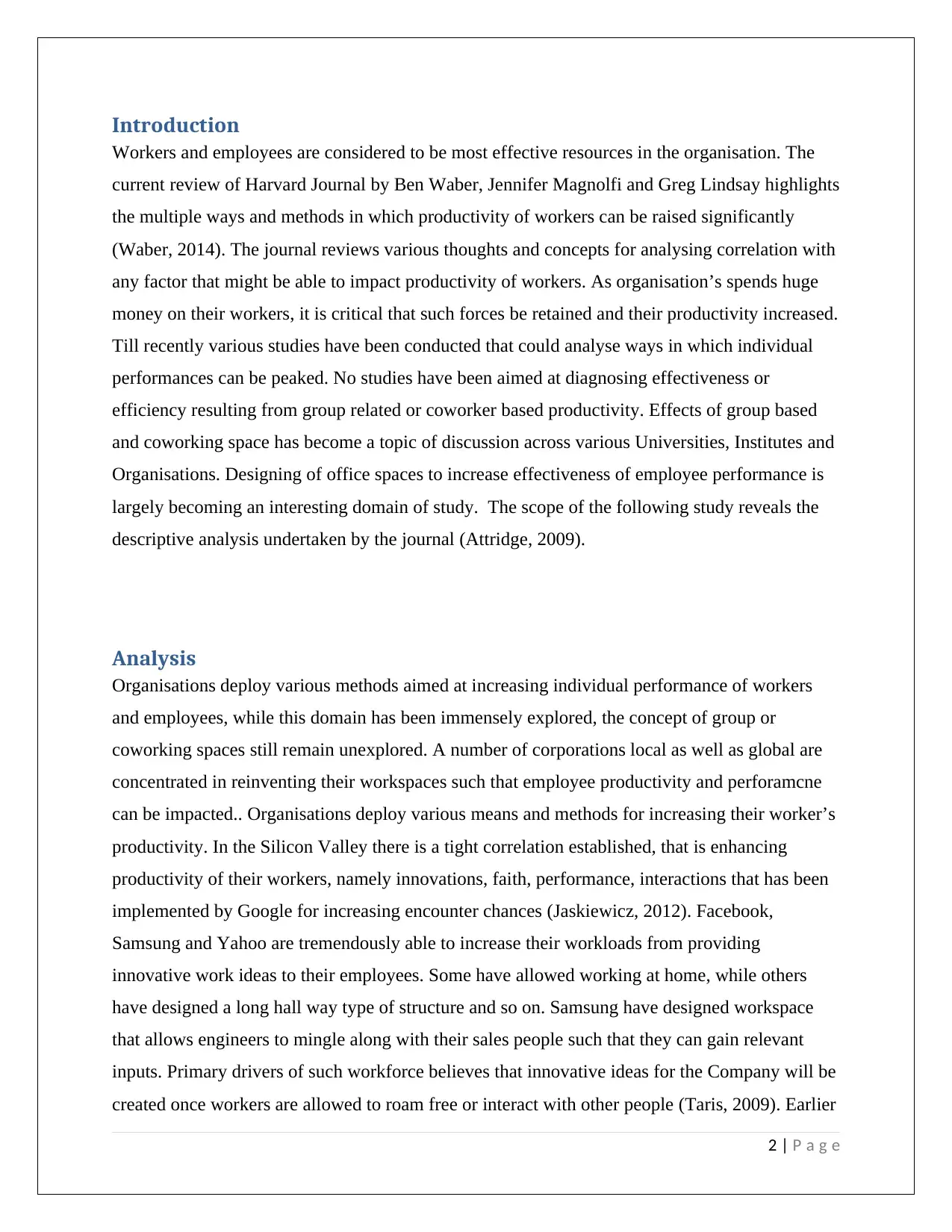
Introduction
Workers and employees are considered to be most effective resources in the organisation. The
current review of Harvard Journal by Ben Waber, Jennifer Magnolfi and Greg Lindsay highlights
the multiple ways and methods in which productivity of workers can be raised significantly
(Waber, 2014). The journal reviews various thoughts and concepts for analysing correlation with
any factor that might be able to impact productivity of workers. As organisation’s spends huge
money on their workers, it is critical that such forces be retained and their productivity increased.
Till recently various studies have been conducted that could analyse ways in which individual
performances can be peaked. No studies have been aimed at diagnosing effectiveness or
efficiency resulting from group related or coworker based productivity. Effects of group based
and coworking space has become a topic of discussion across various Universities, Institutes and
Organisations. Designing of office spaces to increase effectiveness of employee performance is
largely becoming an interesting domain of study. The scope of the following study reveals the
descriptive analysis undertaken by the journal (Attridge, 2009).
Analysis
Organisations deploy various methods aimed at increasing individual performance of workers
and employees, while this domain has been immensely explored, the concept of group or
coworking spaces still remain unexplored. A number of corporations local as well as global are
concentrated in reinventing their workspaces such that employee productivity and perforamcne
can be impacted.. Organisations deploy various means and methods for increasing their worker’s
productivity. In the Silicon Valley there is a tight correlation established, that is enhancing
productivity of their workers, namely innovations, faith, performance, interactions that has been
implemented by Google for increasing encounter chances (Jaskiewicz, 2012). Facebook,
Samsung and Yahoo are tremendously able to increase their workloads from providing
innovative work ideas to their employees. Some have allowed working at home, while others
have designed a long hall way type of structure and so on. Samsung have designed workspace
that allows engineers to mingle along with their sales people such that they can gain relevant
inputs. Primary drivers of such workforce believes that innovative ideas for the Company will be
created once workers are allowed to roam free or interact with other people (Taris, 2009). Earlier
2 | P a g e
Workers and employees are considered to be most effective resources in the organisation. The
current review of Harvard Journal by Ben Waber, Jennifer Magnolfi and Greg Lindsay highlights
the multiple ways and methods in which productivity of workers can be raised significantly
(Waber, 2014). The journal reviews various thoughts and concepts for analysing correlation with
any factor that might be able to impact productivity of workers. As organisation’s spends huge
money on their workers, it is critical that such forces be retained and their productivity increased.
Till recently various studies have been conducted that could analyse ways in which individual
performances can be peaked. No studies have been aimed at diagnosing effectiveness or
efficiency resulting from group related or coworker based productivity. Effects of group based
and coworking space has become a topic of discussion across various Universities, Institutes and
Organisations. Designing of office spaces to increase effectiveness of employee performance is
largely becoming an interesting domain of study. The scope of the following study reveals the
descriptive analysis undertaken by the journal (Attridge, 2009).
Analysis
Organisations deploy various methods aimed at increasing individual performance of workers
and employees, while this domain has been immensely explored, the concept of group or
coworking spaces still remain unexplored. A number of corporations local as well as global are
concentrated in reinventing their workspaces such that employee productivity and perforamcne
can be impacted.. Organisations deploy various means and methods for increasing their worker’s
productivity. In the Silicon Valley there is a tight correlation established, that is enhancing
productivity of their workers, namely innovations, faith, performance, interactions that has been
implemented by Google for increasing encounter chances (Jaskiewicz, 2012). Facebook,
Samsung and Yahoo are tremendously able to increase their workloads from providing
innovative work ideas to their employees. Some have allowed working at home, while others
have designed a long hall way type of structure and so on. Samsung have designed workspace
that allows engineers to mingle along with their sales people such that they can gain relevant
inputs. Primary drivers of such workforce believes that innovative ideas for the Company will be
created once workers are allowed to roam free or interact with other people (Taris, 2009). Earlier
2 | P a g e
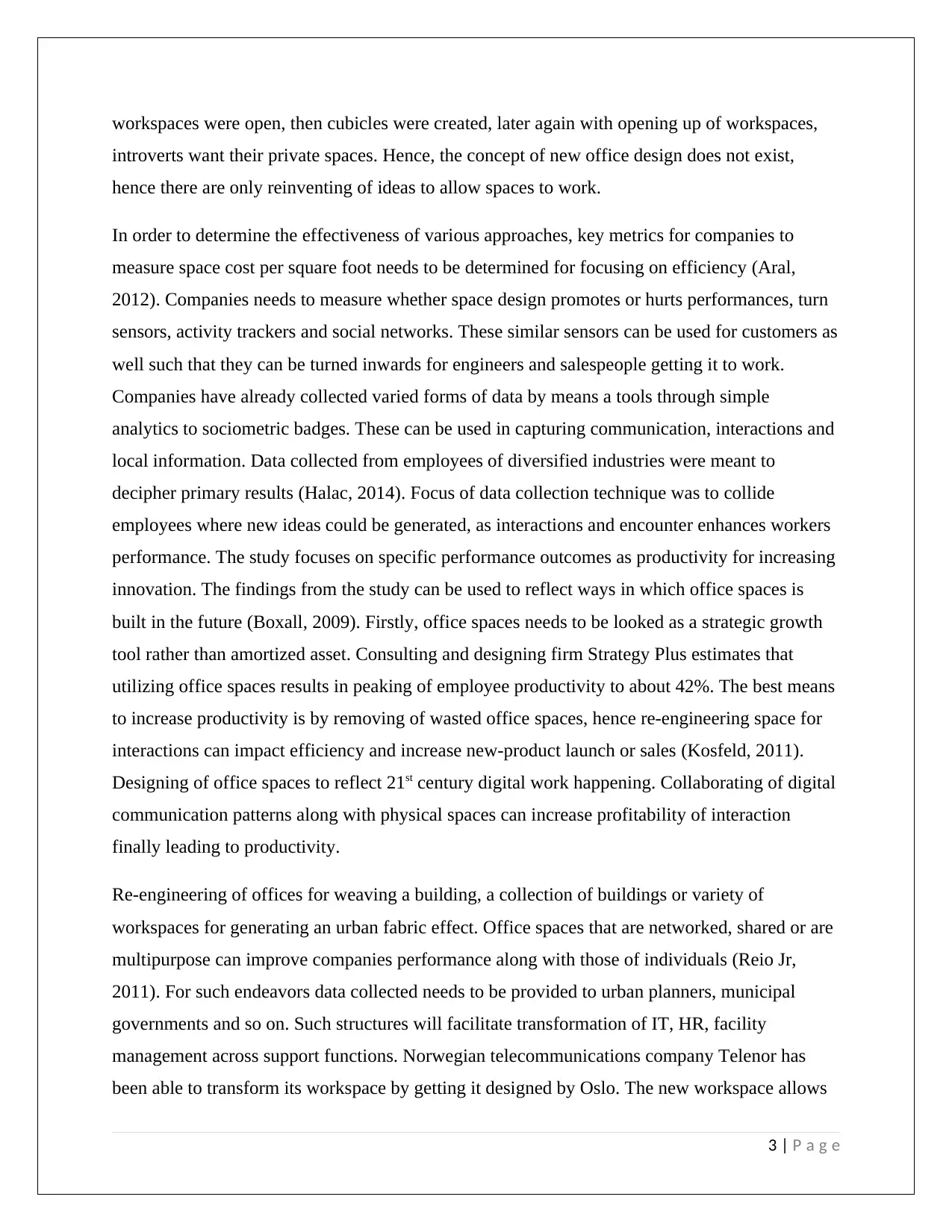
workspaces were open, then cubicles were created, later again with opening up of workspaces,
introverts want their private spaces. Hence, the concept of new office design does not exist,
hence there are only reinventing of ideas to allow spaces to work.
In order to determine the effectiveness of various approaches, key metrics for companies to
measure space cost per square foot needs to be determined for focusing on efficiency (Aral,
2012). Companies needs to measure whether space design promotes or hurts performances, turn
sensors, activity trackers and social networks. These similar sensors can be used for customers as
well such that they can be turned inwards for engineers and salespeople getting it to work.
Companies have already collected varied forms of data by means a tools through simple
analytics to sociometric badges. These can be used in capturing communication, interactions and
local information. Data collected from employees of diversified industries were meant to
decipher primary results (Halac, 2014). Focus of data collection technique was to collide
employees where new ideas could be generated, as interactions and encounter enhances workers
performance. The study focuses on specific performance outcomes as productivity for increasing
innovation. The findings from the study can be used to reflect ways in which office spaces is
built in the future (Boxall, 2009). Firstly, office spaces needs to be looked as a strategic growth
tool rather than amortized asset. Consulting and designing firm Strategy Plus estimates that
utilizing office spaces results in peaking of employee productivity to about 42%. The best means
to increase productivity is by removing of wasted office spaces, hence re-engineering space for
interactions can impact efficiency and increase new-product launch or sales (Kosfeld, 2011).
Designing of office spaces to reflect 21st century digital work happening. Collaborating of digital
communication patterns along with physical spaces can increase profitability of interaction
finally leading to productivity.
Re-engineering of offices for weaving a building, a collection of buildings or variety of
workspaces for generating an urban fabric effect. Office spaces that are networked, shared or are
multipurpose can improve companies performance along with those of individuals (Reio Jr,
2011). For such endeavors data collected needs to be provided to urban planners, municipal
governments and so on. Such structures will facilitate transformation of IT, HR, facility
management across support functions. Norwegian telecommunications company Telenor has
been able to transform its workspace by getting it designed by Oslo. The new workspace allows
3 | P a g e
introverts want their private spaces. Hence, the concept of new office design does not exist,
hence there are only reinventing of ideas to allow spaces to work.
In order to determine the effectiveness of various approaches, key metrics for companies to
measure space cost per square foot needs to be determined for focusing on efficiency (Aral,
2012). Companies needs to measure whether space design promotes or hurts performances, turn
sensors, activity trackers and social networks. These similar sensors can be used for customers as
well such that they can be turned inwards for engineers and salespeople getting it to work.
Companies have already collected varied forms of data by means a tools through simple
analytics to sociometric badges. These can be used in capturing communication, interactions and
local information. Data collected from employees of diversified industries were meant to
decipher primary results (Halac, 2014). Focus of data collection technique was to collide
employees where new ideas could be generated, as interactions and encounter enhances workers
performance. The study focuses on specific performance outcomes as productivity for increasing
innovation. The findings from the study can be used to reflect ways in which office spaces is
built in the future (Boxall, 2009). Firstly, office spaces needs to be looked as a strategic growth
tool rather than amortized asset. Consulting and designing firm Strategy Plus estimates that
utilizing office spaces results in peaking of employee productivity to about 42%. The best means
to increase productivity is by removing of wasted office spaces, hence re-engineering space for
interactions can impact efficiency and increase new-product launch or sales (Kosfeld, 2011).
Designing of office spaces to reflect 21st century digital work happening. Collaborating of digital
communication patterns along with physical spaces can increase profitability of interaction
finally leading to productivity.
Re-engineering of offices for weaving a building, a collection of buildings or variety of
workspaces for generating an urban fabric effect. Office spaces that are networked, shared or are
multipurpose can improve companies performance along with those of individuals (Reio Jr,
2011). For such endeavors data collected needs to be provided to urban planners, municipal
governments and so on. Such structures will facilitate transformation of IT, HR, facility
management across support functions. Norwegian telecommunications company Telenor has
been able to transform its workspace by getting it designed by Oslo. The new workspace allows
3 | P a g e
⊘ This is a preview!⊘
Do you want full access?
Subscribe today to unlock all pages.

Trusted by 1+ million students worldwide
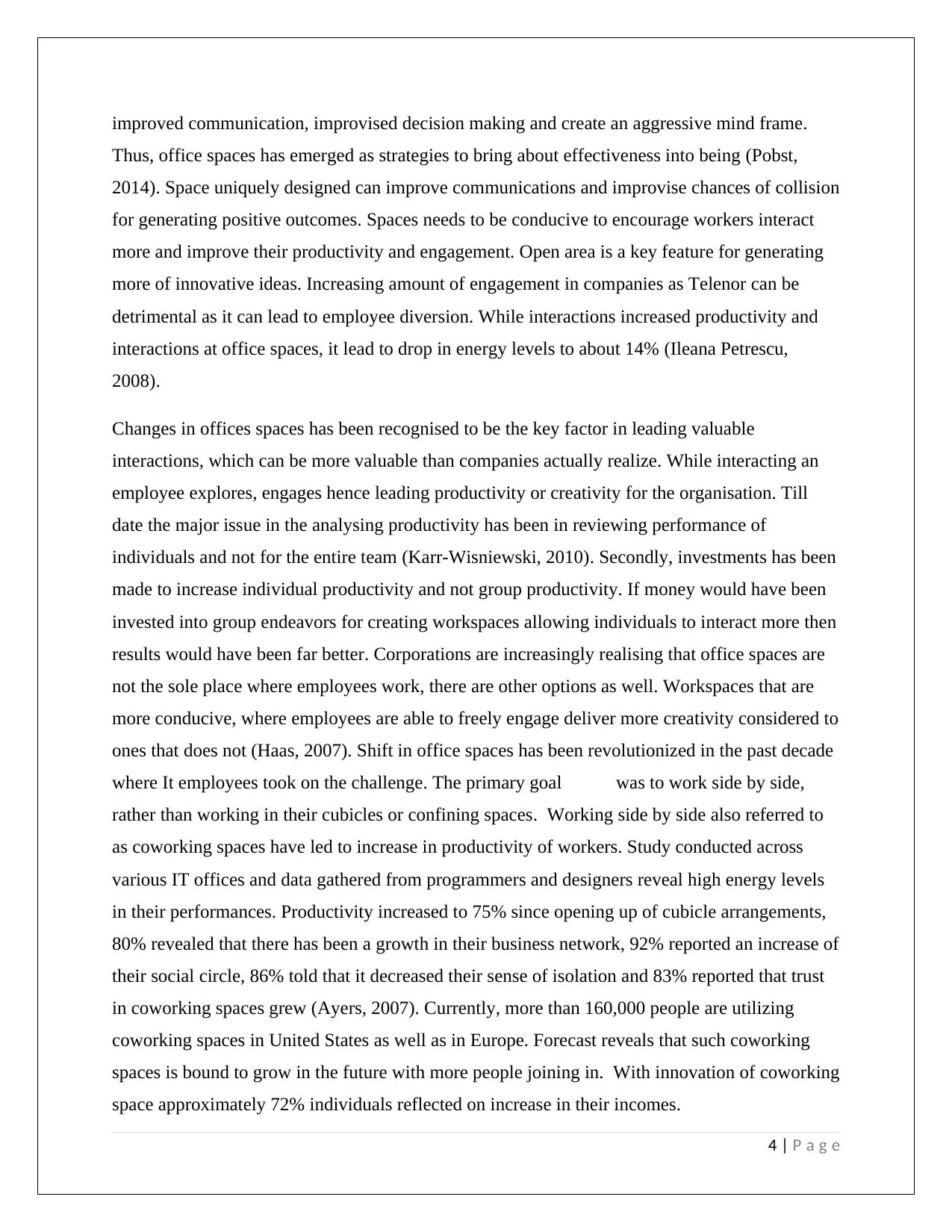
improved communication, improvised decision making and create an aggressive mind frame.
Thus, office spaces has emerged as strategies to bring about effectiveness into being (Pobst,
2014). Space uniquely designed can improve communications and improvise chances of collision
for generating positive outcomes. Spaces needs to be conducive to encourage workers interact
more and improve their productivity and engagement. Open area is a key feature for generating
more of innovative ideas. Increasing amount of engagement in companies as Telenor can be
detrimental as it can lead to employee diversion. While interactions increased productivity and
interactions at office spaces, it lead to drop in energy levels to about 14% (Ileana Petrescu,
2008).
Changes in offices spaces has been recognised to be the key factor in leading valuable
interactions, which can be more valuable than companies actually realize. While interacting an
employee explores, engages hence leading productivity or creativity for the organisation. Till
date the major issue in the analysing productivity has been in reviewing performance of
individuals and not for the entire team (Karr-Wisniewski, 2010). Secondly, investments has been
made to increase individual productivity and not group productivity. If money would have been
invested into group endeavors for creating workspaces allowing individuals to interact more then
results would have been far better. Corporations are increasingly realising that office spaces are
not the sole place where employees work, there are other options as well. Workspaces that are
more conducive, where employees are able to freely engage deliver more creativity considered to
ones that does not (Haas, 2007). Shift in office spaces has been revolutionized in the past decade
where It employees took on the challenge. The primary goal was to work side by side,
rather than working in their cubicles or confining spaces. Working side by side also referred to
as coworking spaces have led to increase in productivity of workers. Study conducted across
various IT offices and data gathered from programmers and designers reveal high energy levels
in their performances. Productivity increased to 75% since opening up of cubicle arrangements,
80% revealed that there has been a growth in their business network, 92% reported an increase of
their social circle, 86% told that it decreased their sense of isolation and 83% reported that trust
in coworking spaces grew (Ayers, 2007). Currently, more than 160,000 people are utilizing
coworking spaces in United States as well as in Europe. Forecast reveals that such coworking
spaces is bound to grow in the future with more people joining in. With innovation of coworking
space approximately 72% individuals reflected on increase in their incomes.
4 | P a g e
Thus, office spaces has emerged as strategies to bring about effectiveness into being (Pobst,
2014). Space uniquely designed can improve communications and improvise chances of collision
for generating positive outcomes. Spaces needs to be conducive to encourage workers interact
more and improve their productivity and engagement. Open area is a key feature for generating
more of innovative ideas. Increasing amount of engagement in companies as Telenor can be
detrimental as it can lead to employee diversion. While interactions increased productivity and
interactions at office spaces, it lead to drop in energy levels to about 14% (Ileana Petrescu,
2008).
Changes in offices spaces has been recognised to be the key factor in leading valuable
interactions, which can be more valuable than companies actually realize. While interacting an
employee explores, engages hence leading productivity or creativity for the organisation. Till
date the major issue in the analysing productivity has been in reviewing performance of
individuals and not for the entire team (Karr-Wisniewski, 2010). Secondly, investments has been
made to increase individual productivity and not group productivity. If money would have been
invested into group endeavors for creating workspaces allowing individuals to interact more then
results would have been far better. Corporations are increasingly realising that office spaces are
not the sole place where employees work, there are other options as well. Workspaces that are
more conducive, where employees are able to freely engage deliver more creativity considered to
ones that does not (Haas, 2007). Shift in office spaces has been revolutionized in the past decade
where It employees took on the challenge. The primary goal was to work side by side,
rather than working in their cubicles or confining spaces. Working side by side also referred to
as coworking spaces have led to increase in productivity of workers. Study conducted across
various IT offices and data gathered from programmers and designers reveal high energy levels
in their performances. Productivity increased to 75% since opening up of cubicle arrangements,
80% revealed that there has been a growth in their business network, 92% reported an increase of
their social circle, 86% told that it decreased their sense of isolation and 83% reported that trust
in coworking spaces grew (Ayers, 2007). Currently, more than 160,000 people are utilizing
coworking spaces in United States as well as in Europe. Forecast reveals that such coworking
spaces is bound to grow in the future with more people joining in. With innovation of coworking
space approximately 72% individuals reflected on increase in their incomes.
4 | P a g e
Paraphrase This Document
Need a fresh take? Get an instant paraphrase of this document with our AI Paraphraser
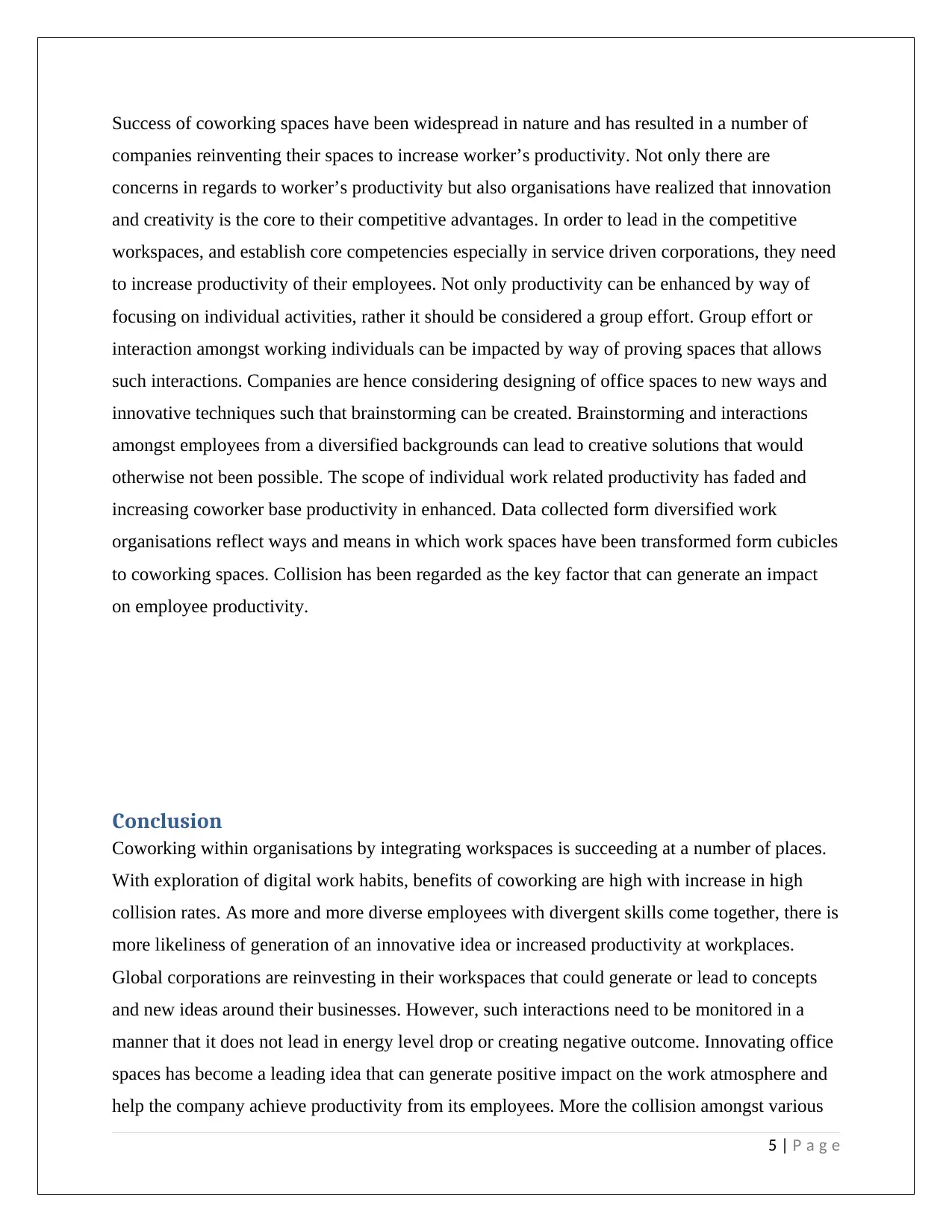
Success of coworking spaces have been widespread in nature and has resulted in a number of
companies reinventing their spaces to increase worker’s productivity. Not only there are
concerns in regards to worker’s productivity but also organisations have realized that innovation
and creativity is the core to their competitive advantages. In order to lead in the competitive
workspaces, and establish core competencies especially in service driven corporations, they need
to increase productivity of their employees. Not only productivity can be enhanced by way of
focusing on individual activities, rather it should be considered a group effort. Group effort or
interaction amongst working individuals can be impacted by way of proving spaces that allows
such interactions. Companies are hence considering designing of office spaces to new ways and
innovative techniques such that brainstorming can be created. Brainstorming and interactions
amongst employees from a diversified backgrounds can lead to creative solutions that would
otherwise not been possible. The scope of individual work related productivity has faded and
increasing coworker base productivity in enhanced. Data collected form diversified work
organisations reflect ways and means in which work spaces have been transformed form cubicles
to coworking spaces. Collision has been regarded as the key factor that can generate an impact
on employee productivity.
Conclusion
Coworking within organisations by integrating workspaces is succeeding at a number of places.
With exploration of digital work habits, benefits of coworking are high with increase in high
collision rates. As more and more diverse employees with divergent skills come together, there is
more likeliness of generation of an innovative idea or increased productivity at workplaces.
Global corporations are reinvesting in their workspaces that could generate or lead to concepts
and new ideas around their businesses. However, such interactions need to be monitored in a
manner that it does not lead in energy level drop or creating negative outcome. Innovating office
spaces has become a leading idea that can generate positive impact on the work atmosphere and
help the company achieve productivity from its employees. More the collision amongst various
5 | P a g e
companies reinventing their spaces to increase worker’s productivity. Not only there are
concerns in regards to worker’s productivity but also organisations have realized that innovation
and creativity is the core to their competitive advantages. In order to lead in the competitive
workspaces, and establish core competencies especially in service driven corporations, they need
to increase productivity of their employees. Not only productivity can be enhanced by way of
focusing on individual activities, rather it should be considered a group effort. Group effort or
interaction amongst working individuals can be impacted by way of proving spaces that allows
such interactions. Companies are hence considering designing of office spaces to new ways and
innovative techniques such that brainstorming can be created. Brainstorming and interactions
amongst employees from a diversified backgrounds can lead to creative solutions that would
otherwise not been possible. The scope of individual work related productivity has faded and
increasing coworker base productivity in enhanced. Data collected form diversified work
organisations reflect ways and means in which work spaces have been transformed form cubicles
to coworking spaces. Collision has been regarded as the key factor that can generate an impact
on employee productivity.
Conclusion
Coworking within organisations by integrating workspaces is succeeding at a number of places.
With exploration of digital work habits, benefits of coworking are high with increase in high
collision rates. As more and more diverse employees with divergent skills come together, there is
more likeliness of generation of an innovative idea or increased productivity at workplaces.
Global corporations are reinvesting in their workspaces that could generate or lead to concepts
and new ideas around their businesses. However, such interactions need to be monitored in a
manner that it does not lead in energy level drop or creating negative outcome. Innovating office
spaces has become a leading idea that can generate positive impact on the work atmosphere and
help the company achieve productivity from its employees. More the collision amongst various
5 | P a g e
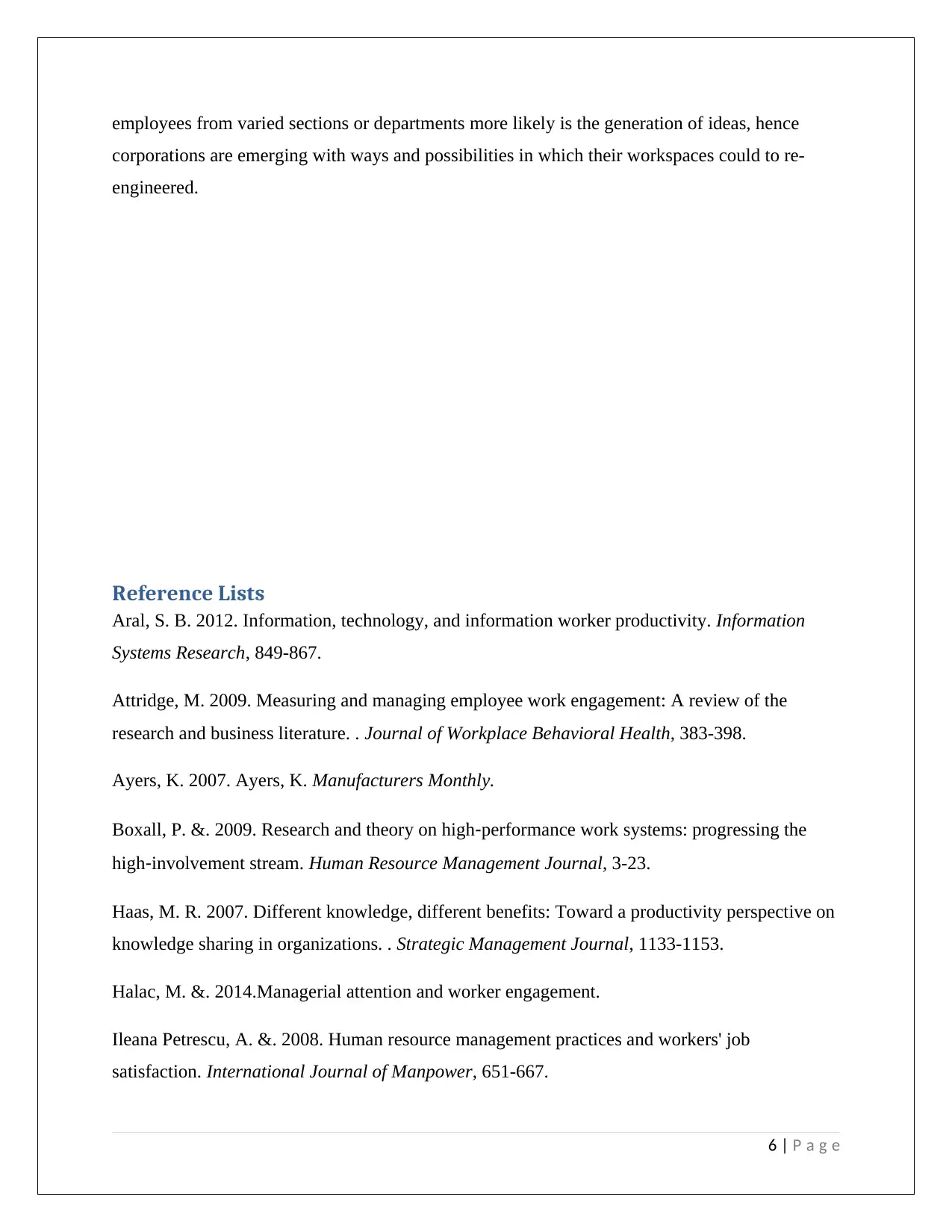
employees from varied sections or departments more likely is the generation of ideas, hence
corporations are emerging with ways and possibilities in which their workspaces could to re-
engineered.
Reference Lists
Aral, S. B. 2012. Information, technology, and information worker productivity. Information
Systems Research, 849-867.
Attridge, M. 2009. Measuring and managing employee work engagement: A review of the
research and business literature. . Journal of Workplace Behavioral Health, 383-398.
Ayers, K. 2007. Ayers, K. Manufacturers Monthly.
Boxall, P. &. 2009. Research and theory on high‐performance work systems: progressing the
high‐involvement stream. Human Resource Management Journal, 3-23.
Haas, M. R. 2007. Different knowledge, different benefits: Toward a productivity perspective on
knowledge sharing in organizations. . Strategic Management Journal, 1133-1153.
Halac, M. &. 2014.Managerial attention and worker engagement.
Ileana Petrescu, A. &. 2008. Human resource management practices and workers' job
satisfaction. International Journal of Manpower, 651-667.
6 | P a g e
corporations are emerging with ways and possibilities in which their workspaces could to re-
engineered.
Reference Lists
Aral, S. B. 2012. Information, technology, and information worker productivity. Information
Systems Research, 849-867.
Attridge, M. 2009. Measuring and managing employee work engagement: A review of the
research and business literature. . Journal of Workplace Behavioral Health, 383-398.
Ayers, K. 2007. Ayers, K. Manufacturers Monthly.
Boxall, P. &. 2009. Research and theory on high‐performance work systems: progressing the
high‐involvement stream. Human Resource Management Journal, 3-23.
Haas, M. R. 2007. Different knowledge, different benefits: Toward a productivity perspective on
knowledge sharing in organizations. . Strategic Management Journal, 1133-1153.
Halac, M. &. 2014.Managerial attention and worker engagement.
Ileana Petrescu, A. &. 2008. Human resource management practices and workers' job
satisfaction. International Journal of Manpower, 651-667.
6 | P a g e
⊘ This is a preview!⊘
Do you want full access?
Subscribe today to unlock all pages.

Trusted by 1+ million students worldwide
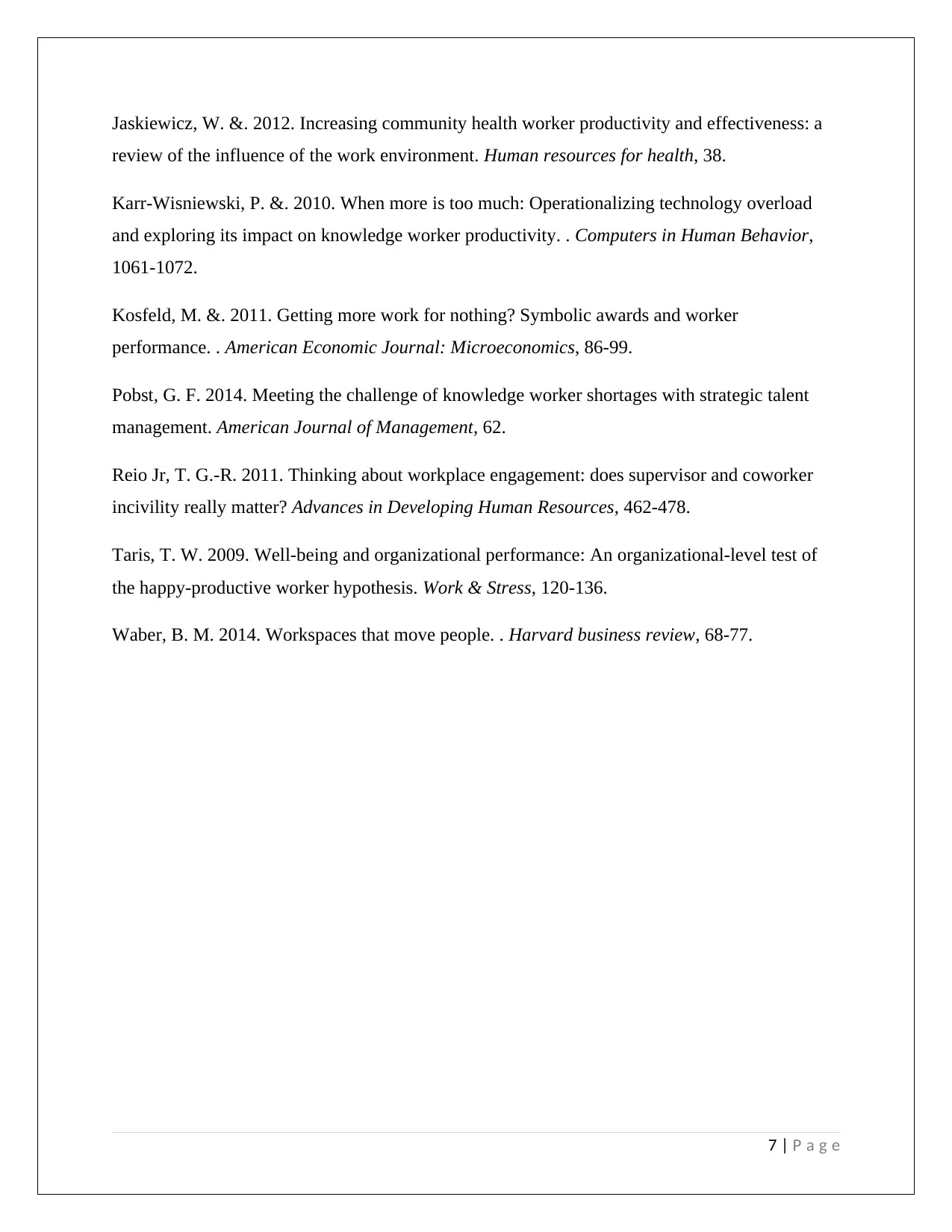
Jaskiewicz, W. &. 2012. Increasing community health worker productivity and effectiveness: a
review of the influence of the work environment. Human resources for health, 38.
Karr-Wisniewski, P. &. 2010. When more is too much: Operationalizing technology overload
and exploring its impact on knowledge worker productivity. . Computers in Human Behavior,
1061-1072.
Kosfeld, M. &. 2011. Getting more work for nothing? Symbolic awards and worker
performance. . American Economic Journal: Microeconomics, 86-99.
Pobst, G. F. 2014. Meeting the challenge of knowledge worker shortages with strategic talent
management. American Journal of Management, 62.
Reio Jr, T. G.-R. 2011. Thinking about workplace engagement: does supervisor and coworker
incivility really matter? Advances in Developing Human Resources, 462-478.
Taris, T. W. 2009. Well-being and organizational performance: An organizational-level test of
the happy-productive worker hypothesis. Work & Stress, 120-136.
Waber, B. M. 2014. Workspaces that move people. . Harvard business review, 68-77.
7 | P a g e
review of the influence of the work environment. Human resources for health, 38.
Karr-Wisniewski, P. &. 2010. When more is too much: Operationalizing technology overload
and exploring its impact on knowledge worker productivity. . Computers in Human Behavior,
1061-1072.
Kosfeld, M. &. 2011. Getting more work for nothing? Symbolic awards and worker
performance. . American Economic Journal: Microeconomics, 86-99.
Pobst, G. F. 2014. Meeting the challenge of knowledge worker shortages with strategic talent
management. American Journal of Management, 62.
Reio Jr, T. G.-R. 2011. Thinking about workplace engagement: does supervisor and coworker
incivility really matter? Advances in Developing Human Resources, 462-478.
Taris, T. W. 2009. Well-being and organizational performance: An organizational-level test of
the happy-productive worker hypothesis. Work & Stress, 120-136.
Waber, B. M. 2014. Workspaces that move people. . Harvard business review, 68-77.
7 | P a g e
1 out of 7
Related Documents
Your All-in-One AI-Powered Toolkit for Academic Success.
+13062052269
info@desklib.com
Available 24*7 on WhatsApp / Email
![[object Object]](/_next/static/media/star-bottom.7253800d.svg)
Unlock your academic potential
Copyright © 2020–2025 A2Z Services. All Rights Reserved. Developed and managed by ZUCOL.





